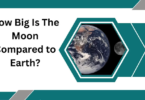The Moon, Earth’s sole natural satellite, has long captivated the imaginations of people across the globe. As our celestial companion, the Moon plays a significant role in various aspects of our planet’s existence, from the tides that shape our coastlines to the inspiration behind countless cultural and scientific achievements. Comparing the size of the Moon to that of Earth offers a fascinating glimpse into the scale of our universe and reveals intriguing insights about the formation and evolution of both celestial bodies. In this article, we will delve into the dimensions and characteristics of the Moon and Earth, examining their differences and similarities, and exploring the unique relationship that exists between these two celestial neighbor’s.
How Did The Moon Form?
Table of Contents
The most widely accepted theory about the formation of the Moon is called the Giant Impact Hypothesis, also known as the Theia Impact or Big Splash. According to this theory, approximately 4.5 billion years ago, a Mars-sized celestial body called Theia collided with the early Earth in a catastrophic impact. The tremendous energy released during this collision resulted in the ejection of a massive amount of debris into space.
This ejected material eventually coalesced under the influence of gravity to form the Moon. Over time, the Moon’s orbit around Earth stabilised, and it became tidally locked, meaning that the same side of the Moon always faces Earth.
The Giant Impact Hypothesis is supported by several lines of evidence. For example, the Moon’s composition is similar to that of Earth’s mantle, suggesting a common origin for the two bodies. Additionally, the isotopic ratios of certain elements found in lunar samples match those found on Earth, further reinforcing the idea that the Moon formed from material ejected during the impact.
What Is the Moon’s Atmosphere Like?
The Moon has an extremely thin and tenuous atmosphere, known as an exosphere. In fact, it is so sparse that it is often referred to as a near-vacuum. The Moon’s exosphere consists of a very low density of particles, including atoms and molecules such as helium, neon, argon, sodium, and potassium. These particles do not collide or interact with each other like they would in a denser atmosphere, due to their extremely low concentrations.
The lack of a significant atmosphere on the Moon can be attributed to its relatively small mass and weak gravity, which are not strong enough to retain a dense atmosphere over geological timescales. Additionally, the Moon lacks a substantial magnetic field, which means it cannot protect its atmosphere from being stripped away by solar wind and other space weather phenomena.
The absence of a substantial atmosphere on the Moon has several important consequences. For one, it means that there is no weather or wind on the lunar surface. Additionally, the lack of an atmosphere contributes to the extreme temperature fluctuations experienced on the Moon, as there is no insulating layer to trap heat or distribute it evenly. Temperatures on the Moon can range from around -173°C (-280°F) during the lunar night to 127°C (260°F) at noon during the lunar day.
What Are The Phases Of The Moon And How Do They Occur?
The phases of the Moon are the different appearances of the illuminated portion of the Moon as seen from Earth. These phases occur due to the changing relative positions of the Moon, Earth, and Sun as the Moon orbits Earth. There are eight main phases, which are:
New Moon
The Moon is between Earth and the Sun, and the side of the Moon facing Earth is not illuminated. The Moon is almost invisible from Earth during this phase.
Waxing Crescent
After the New Moon, a thin sliver of the Moon’s illuminated side becomes visible on Earth. The illuminated portion increases (“waxes”) each day until it reaches the First Quarter phase.
First Quarter
Half of the Moon’s Earth-facing side is illuminated during this phase. The Moon appears as a semicircle in the sky.
Waxing Gibbous
The illuminated portion of the Moon continues to increase, with more than half but less than the entire Earth-facing side visible. The Moon is now “gibbous,” which means its shape is convex or bulging outward.
Full Moon
The entire Earth-facing side of the Moon is illuminated. Earth is between the Moon and the Sun during this phase, and the Moon appears as a fully illuminated circle.
Waning Gibbous
After the Full Moon, the illuminated portion of the Moon starts to decrease (“wane”), and the Moon appears as a gibbous shape once again.
Third Quarter (or Last Quarter)
The Moon has completed three-quarters of its orbit around Earth, and half of the Earth-facing side is illuminated. The Moon appears as a semicircle again, but the illuminated portion is opposite to that of the First Quarter.
Waning Crescent
The illuminated portion of the Moon continues to decrease, appearing as a thinning crescent shape in the sky. Eventually, the Moon returns to the New Moon phase, and the cycle begins anew.
The entire cycle of Moon phases, from one New Moon to the next, takes approximately 29.5 days and is called a lunar month or synodic month. The phases of the Moon have been used throughout human history to track time and inform calendars, agriculture, and cultural practices.
How Far Is The Moon from Earth?
The distance between the Moon and Earth varies due to the elliptical nature of the Moon’s orbit. On average, the Moon is about 384,400 kilometres (238,855 miles) away from Earth. This distance is not constant, as the Moon’s orbit has a slight eccentricity, causing it to be closer to Earth at some points (called perigee) and farther away at others (called apogee).
At perigee, the Moon is approximately 363,300 kilometres (225,623 miles) from Earth, while at apogee, it is about 405,500 kilometres (251,966 miles) away. The difference in distance between perigee and apogee can cause the Moon to appear larger or smaller in the sky, depending on its current position in its orbit. This variation is most noticeable during events like a “supermoon,” when the Moon is both full and near its perigee, making it appear larger and brighter than usual.
What Is The Gravitational Force Between Earth And The Moon?
The gravitational force between Earth and the Moon is a result of their masses and the distance between them. To calculate this force, we can use Newton’s law of universal gravitation, which states:
F = (G * m1 * m2) / r^2
where F is the gravitational force, G is the gravitational constant (approximately 6.674 x 10^-11 N m²/kg²), m1 and m2 are the masses of the two objects (in this case, Earth and the Moon), and r is the distance between their centers of mass.
The mass of Earth is approximately 5.972 x 10^24 kg, and the mass of the Moon is about 7.342 x 10^22 kg. As previously mentioned, the average distance between Earth and the Moon is roughly 384,400 kilometers (238,855 miles), which we need to convert to meters (384,400,000 meters).
Using these values, we can calculate the gravitational force between Earth and the Moon:
F = (6.674 x 10^-11 N m²/kg²) * (5.972 x 10^24 kg) * (7.342 x 10^22 kg) / (384,400,000 m)^2
F ≈ 1.982 x 10^20 N
The gravitational force between Earth and the Moon is approximately 1.982 x 10^20 newtons. This force is responsible for keeping the Moon in orbit around Earth, as well as causing the tides on Earth due to the gravitational pull of the Moon on Earth’s oceans.
How Big Is The Moon Compared To The Earth?
In terms of size, the Moon is significantly smaller than Earth. Here is a comparison of their dimensions and characteristics:
- Diameter
The Moon has a diameter of approximately 3,474 kilometers (2,159 miles), while Earth’s diameter is about 12,742 kilometers (7,918 miles). This means that the Moon’s diameter is about 27% that of Earth.
- Surface Area
The Moon’s surface area is approximately 37.94 million square kilometers (14.6 million square miles), while Earth has a surface area of around 510.1 million square kilometers (196.9 million square miles). The Moon’s surface area is about 7.4% of Earth’s.
- Volume
The Moon has a volume of roughly 21.9 billion cubic kilometers (5.3 billion cubic miles), while Earth has a volume of approximately 1 trillion cubic kilometers (261 billion cubic miles). The Moon’s volume is just about 2% of Earth’s.
- Mass
The Moon’s mass is about 7.342 x 10^22 kg, whereas Earth’s mass is approximately 5.972 x 10^24 kg. This means that the Moon’s mass is only around 1.2% of Earth’s mass.
In summary, the Moon is much smaller than Earth in terms of diameter, surface area, volume, and mass.
How Long Does It Take For The Moon To Orbit Earth?
The Moon takes approximately 27.3 days to complete one full orbit around Earth. This period is called the sidereal month and is measured relative to the stars. During this time, the Moon travels a distance of about 2.41 million kilometers (1.5 million miles) in its elliptical orbit.
However, when considering the phases of the Moon as observed from Earth, we need to account for the time it takes for the Moon to return to the same phase (e.g., from one Full Moon to the next). This period is called the synodic month, or lunar month, and lasts about 29.5 days. The difference between the sidereal and synodic months arises because Earth is also orbiting the Sun during this time, so the Moon has to travel slightly more than one full orbit to return to the same phase as viewed from Earth.
Frequently Asked Questions
Q1: What is the dark side of the Moon?
Ans: The “dark side” refers to the far side of the Moon, which is not visible from Earth due to tidal locking.
Q2: What causes lunar eclipses?
Ans: Lunar eclipses occur when Earth’s shadow falls on the Moon, blocking sunlight and causing it to darken.
Q3: How does the Moon’s gravity compared to Earth’s?
Ans: The Moon’s gravity is about 1/6th (16.6%) as strong as Earth’s gravity, due to its smaller size and mass.
Q4: What causes tides on Earth?
Ans: Tides are caused by the gravitational pull of the Moon and, to a lesser extent, the Sun.
Q5: Does the Moon rotate?
Ans: Yes, the Moon rotates on its axis, taking about 27.3 days for one rotation.







